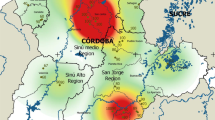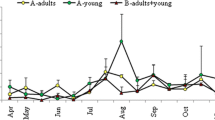Summary
A study on the seasonal variations in the population structure ofHaemonchus contortus andTrichostronglyus colubriformis was conducted for a period of 12 months in a typical large scale sheep farm on improved pasture in Peninsular Malaysia which has a wet tropical climate. Successive groups of helminth-free tracer lambs were grazed for 4 weeks together with naturally infected sheep and were necropised for worm counts 2 weeks after their removal from the pasture. The monthly populations ofH. contortus fluctuated slightly except in May and August during which more worms were found in the tracer animals. The numbers ofT. colubriformis were comparatively high from October to December 1992 and again in March 1993, low during April and June 1992. Small numbers of hypobiotic larvae ofH. contortus were detected in the tracer animals. Development and survival of infective larvae ofH. contortus andT. colubriformis on pasture were investigated by spreading faeces containing eggs on grass plots in October 1993, February and May 1994. Development of the eggs to the infective larvae occurred within one week and their survival times were 7 weeks in the 3 experiments. The potential for control by rotational grazing is discussed.
Résumé
Une étude fut menée sur les variations saisonnières des populations deHaemonchus contortus etTrichostrongylus colubriformis pendant 12 mois dans une ferme traditionnelle de large structure et avec des paturages de qualité dans une zone tropicale humide de la péninsule malaysienne. Plusieurs groupes d’agneaux servant de sentinelle, sans helminthes, furent mélangés pendant 4 semaines sur un pré avec des moutons naturellement infectés puis furent autopsiés 2 semaines après leur départ du pré, les helminthes furent alors dénombrés. Les populations deH. contortus fluctuèrent légèrement chaque mois sauf en Mai et en Août pendant lesquels le nombre d’helminthes fut plus important chez les animaux sentinels. Le nombre deT. colubriformis fut comparativement élevé d’Octobre à Décembre 1992 et de même en Mars 1993, et faible en Avril et Juin 1992. Un faible nombre de larves deH. contortus furent retrouvées dans les animaux sentinels. Le développement et la survie de larves infectives deH. contortus etT. colubriformis sur le paturage fut étudrié en étalant des féces infectés sur l’herbe en Octobre 1993, Février et Mai 1994. Le développment des oeufs en larves infectantes se produisit en une semaine et les larves vécurent 7 semaines pour les 3 expériences. Les possibilités de contrôle par broutage rotationnel sont discutées.
Resumen
Se realizó un estudio sobre las variaciones estacionales en la estructura de la población deHaemonchus contortus yTrichostrongylus colubriformis durante un período de 12 meses en una gran explotación ovina de pastos abonados en la península de Malasia, con un clima tropical húmedo. Sucesivos grupos de corderos libres de helmintos pastaron durante 4 semanas con ovejas infectadas de forma natural, y se les realizó la necropsia para el recuento de helmintos 2 semanas después de la salida del prado. La población mensual deH. contortus fluctuó ligeramente excepto en mayo y agosto, donde a los animales en estudio se les encontraron más helmintos. El número deT. colubriformis fue comparativamente alto de octubre a diciembre de 1992 y en marzo de 1993 y bajo durante abril y junio de 1992. Se detectó un bajo número de larvas hipobióticas deH. contortus en los animales estudiados. Se estudió el desarrollo y la supervivencia de las larvas infectivas deH. contortus yT. colubriformis en el pasto a partir de los huevos de las heces diseminadas por el prado en octubre de 1993, febrero y mayo de 1994. El desarrollo de huevo a larva infectiva ocurrió dentro de la primera semana y el tiempo de supervivencia fue de 7 semanas en los 3 experimentos. Se discute el potencial de control por pastoreo rotacional.
Similar content being viewed by others
References
Altaif, K. I. &Yakoob, A. Y. (1987). Development and survival ofHaemonchus contortus larvae on pasture in Iraq.Tropical Animal Health and Production,19, 88–92.
Anon (1977).Manual of Veterinary Parasitological Laboratory Techniques. Technical Bulletin No. 18, 2nd ed. Ministry of Agriculture, Fisheries and Food, HMSO, London.
Aumont, G. &Gruner, L. (1989). Population evolution of the free-living stages of goat gastrointestinal nematodes on herbage under tropical conditions in Guadeloupe (French West Indies).International Journal for Parasitology,19, 539–546.
Banks, D. J. D., Singh, R., Barger, I. A. &Le Jamber, L. F. (1990). Development and survival of infective larvae ofHaemonchus contortus andTrichostrongylus colubriformis on pasture in a tropical environment.International Journal for Parasitology,20, 155–160.
Barger, I. A., Siale, K., Banks, D. J. D. &Le Jambre, L. F. (1994). Rotational grazing control of gastrointestinal nematodes of goats in a wet tropical environment.Veterinary Parasitology,53, 109–116.
Chandrawathani, P., Jamnah, O. & Rajamanickam, C. (1995). Testing potential control programmes for helminthiasis in sheep on open pasture. Proceedings of the 17th Malaysian Society of Animal Production (MSAP) Annual Conference, Penang, Malaysia, pp 112–113.
Chiejina, S. N. (1982). Evaluation of modified Baermann apparatus for the recovery of infective trichostrongylid larvae from herbage samples.Journal of Helminthology,56, 105–109.
Chiejina, S. N. &Fakae, B. B. (1984). Development and survival of infective larvae of gastrointestinal nematode parasites of cattle on pasture in eastern Nigeria.Research in Veterinary Science,37, 148–153.
Chiejina, S. N., Fakae, B. B. &Eze, P. I. (1989). Development and survival of free-living stages of gastrointestinal nematodes of sheep and goats on pasture in the Nigerian derived savanna.Veterinary Research Communications,13, 103–112.
Copeman, D. B. (1980). The importance of helminth parasites in animal production systems in the tropics. Proceedings of First Asian-Australasian Animal Science Congress, Serdang, Malaysia, 91–97.
Gibbs, H. C. (1982). Mechanisms of survival of nematode parasites with emphasis on hypobiosis.Veterinary Parasitology,11, 25–48.
Gibson, T. E. &Everett, G. (1967). The ecology of the free-living stages ofTrichostrongylus colubriformis.Parasitology,57, 533–547.
Ikeme, M. M., Fatimah, I. &Lee, C. C. (1986). Seasonal incidence of infective nematode larvae on pasture and nematode worm populations of goats in Selangor.Kajian Veterinare,18, 69–76.
Ikeme, M. M., Fatimah, I. &Lee, C. C. (1987). Seasonal changes in the prevalence ofHaemonchus andTrichostrongylus hypobiotic larvae in tracer goats in Malaysia.Tropical Animal Health and Production,19, 184–190.
Levine, N. D. (1963). Weather, climate and the bionomics of ruminant nematode larvae. In:Advances in Veterinary Science, Academic Press, New York and London.
Levine, N. D., Todd, K. S. &Boatman, P. A. (1974). Development and survival ofHaemonchus contortus on pasture.American Journal of Veterinary Research,35, 1,413–1,422.
Ogunsusi, R. A. (1979). Pasture infectivity with trichostrongylid larvae in the northern Guinea Savanna of Nigeria.Research in Veterinary Science,26, 320–323.
Ogunsusi, R. A. &Eysker, M. (1979). Inhibited development of trichostrongylids of sheep in Northern Nigeria.Research in Veterinary Science,26, 108–110.
Okon, E. D. &Enyenihi, U. K. (1977). Development and survival ofHaemonchus contortus larvae on pasture in Ibadan.Tropical Animal Health and Production,9, 7–10.
Pandey, V. S. &Sivaraj, S. (1994). Anthelmintic resistance inHaemonchus contortus from sheep in Malaysia.Veterinary Parasitology,53, 67–74.
Rose, J. H. (1963). Observations on the free-living stages of the stomach worm,Haemonchus contortus.Parasitiology,53, 469–481.
Sani, R. A. & Rajamanickam, C. (1990). Gastrointestinal parasitism in small ruminants. Proceedings of a Workshop on Research Methodologies, Sumatra, Indonesia, pp 197–201.
Schillhorn Van Veen, T. W. (1978). HAEMONCHOSIS IN SHEEP DURING THE DRY SEASON IN THE NIGERIAN SAVANNA.VETERINARY RECORD,102, 364–365.
Tajuddin, I. & Chong, D. T. (1988). Rubber Research Institute of Malaysia research on sheep integration with rubber. Proceedings, Symposium on Sheep Production in Malaysia, 73–82.
Vercruysse, J. (1984/85). The seasonal prevalence of inhibited development ofHaemonchus contortus in sheep in Senegal.Veterinary Parasitology,17, 159–163.
Author information
Authors and Affiliations
Rights and permissions
About this article
Cite this article
Cheah, T.S., Rajamanickam, C. Epidemiology of gastro-intestinal nematodes of sheep in wet tropical conditions in Malaysia. Trop Anim Health Prod 29, 165–173 (1997). https://doi.org/10.1007/BF02633015
Accepted:
Issue Date:
DOI: https://doi.org/10.1007/BF02633015




